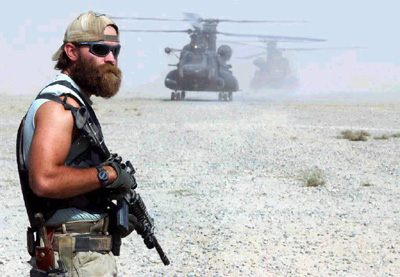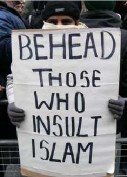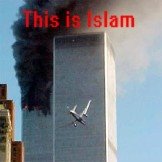Should the President inform Americans of nuclear threat to U.S. homeland? Maybe he just did...
By Cliff Montgomery, SecretsOfSurvival.com
Worries are simmering that al-Qaeda may somehow strike an American city with a nuclear weapon. Most people of course consider this unlikely; government however seems to be taking it a lot more seriously.
In fact, an expert group of government and military officials is putting together an emergency survival program which recommends the building of bomb shelters, steps to prevent panicked evacuations and – perhaps tellingly – the possible 'temporary' elimination of our civil liberties.
Also known as Martial Law.
Many experts say the possibility of al-Qaeda, or any other terrorist group, obtaining a working nuclear weapon is rather small.
Atleast, they used to say that. I guess it depends on who you talk to. Some would say it's a small possibility. Others, like our Vice-President, state it is now a 'daily threat' and now the top concern of Homeland Security.
CHICAGO TRIBUNE: Cheney: Nuclear attack on U.S cities 'very real'
Does Cheney know something we don't? Most likely.
Last month, top government and military officials and other experts – organized by a joint Stanford-Harvard enterprise called the Preventive Defense Project – quietly met in Washington for a day-long symposium to hash out a blueprint for human survival after a full-scale nuclear holocaust.
The discussion, called "The Day After," took as its basis the idea that efforts focusing on nuclear strike prevention may fail, and that the possible collapse of government rule may necessitate putting in place a contingency program.
Two men organized the non-partisan project – Stanford's William Perry, a secretary of defense during the Clinton Administration, and Harvard's Ashton Carter, a senior Defense Department official for the Clinton White House.
Project members assumed a nuclear bomb similar in size to the one which destroyed Hiroshima in World War II had detonated in a major U.S. city. While packing a wallop of around 10 to 15 kilotons, such a weapon is small – at least when compared with most Cold War-era warheads – and is a relatively simple bomb. Still, it's hardly the kind of easy-to-hide, portable weapon al-Qaeda might use...
The 41 experts discussed how the U.S. government could best respond to offset a second nuclear attack, to curtail health problems from any radioactive fallout, and to restore political rule. Project comments were made "confidential", although a few participants freely described the exchange of views to the San Francisco Chronicle.
Some responses were more colorful than others. Fred Ikle, a former Defense Department official under Ronald Reagan whose 2006 book urged attack preparation, Annihilation from Within, claimed that the government "should plan how it could restrict civil liberties and enforce...martial law in the aftermath of a nuclear attack," but also lay down guidelines for how our liberties might later be restored, according to the Chronicle.
But there's one problem with Ikle's scenario: once a government assumes absolute power, it almost never gives it back willingly.
Our new masters may continually argue that there's another big bully just around the corner who may be planning to do us ill. And since there will always be someone wishing us ill somewhere on this globe, they will always have a reason to maintain their dictatorship.
Mr. Ikle's idea that the U.S. government must immediately declare war on American freedom if we suffer an all-out nuclear attack didn't sit well with many other panel members, several said.
Some participants heatedly retorted that our freedom is our greatest protection. They said the federal government instead needs to immediately educate first responders and other citizens on maintaining proper procedure even if the government is unable to issue orders, as seems more likely.
"Your cities would empty and people would completely lose confidence in the ability of the government to protect them...you'd have nothing that resembles our current social order," answered Steve Fetter, dean of the School of Public Policy at the University of Maryland. Such experts declare this is what makes publicly available information on possible attacks and contingency plans so necessary.
In fact on Sept. 11th, 2001, we had an essential breakdown of government rule. The president flew to Omaha, Nebraska, the vice-president hid in "an undisclosed location", and for hours the federal government essentially left us to our own devices.
Under attack and without direct government rule, Americans actually became more caring of others, not less. The pressing issue was not a breakdown of civil order but a lack of citizen preparation – no one knew what to do either during or after the attacks.
The information which all Americans most need for self-protection is referred to in intelligence circles as "open source intelligence" (OSINT) – pertinent information which is not classified, but is instead available to all.
And who reported in December 2006 that OSINT is "not a luxury but a necessity" for security? The U.S. Army of course – the very people Mr. Ikle will install as our masters, if only the right opportunity shows itself.
Here's a few highlights from the Army report, as quoted by the news website, AmericanSpark.com:
"Our reliance on classified databases and external support has...often left our soldiers uninformed and ill-prepared to capitalize on the huge reservoir of unclassified information available from open sources.
"From El Salvador to Iraq, the US Army operates in diverse operational environments around the World. These diverse operational environments mean the development and use of OSINT is not a luxury but a necessity.
"Open sources possess much of the information that we need to understand the physical and human factors of the operational environments in which we conduct or may conduct...operations. In truth, much of our understanding of these environments – our World – is based on publicly available information that we learned from educators, journalists, news anchors, and scholars."
Further Reading:
SAN. FRAN. CHRONICLE: United States drafts 'Day After' nuclear plan
L.A. TIMES: Bush orders contingency plans for nuclear attack on U.S.
NEWSMAX.COM: Author: Al-Qaida Has Nuclear Weapons Inside U.S.
skip to main |
skip to sidebar











"We sleep safe in our beds because rough men stand ready in the night to visit violence on those who would do us harm." -- George Orwell
Support BlackPorter
Profile:

- Blackporter
- Preparation is not paranoia. Paranoia is the result of lack of preparation.
Tracking & Analysis Links:
Terrorism Analysts:
Alternative:
Podcasts:
ENDGAME
Glenn Beck on Mahmoud Ahmadinejad 1 of 2
Glenn Beck on Mahmoud Ahmadinejad 2 of 2
Dr. Bill Wattenburg US Nuclear Attack
Dr. Paul Williams at The Counter Terrorism Conference in Ames, Iowa.
Dr. Bill Wattenburg on American Greatness
Massive terror attack on America imminent!
Dennis on the Six Imams
Great example of what we're fighting for!
Our Future?
Have You Forgotten?
Why are we in Iraq?
Good Causes:
Web Articles:
-
▼
2007
(26)
-
▼
July
(18)
- Watch Out For Dry Runs
- Military Commander Believes al Qaeda Terror Cells ...
- Officials Worried Over Terror Sleeper Cells
- Al Qaeda & WMD Threat
- How to Survive the Last Days
- If America Falls...you'll find BlackPorter in the ...
- Chertoff's 'Gut Feeling' Could Be a Nuclear Detona...
- Al Qaeda Cell in the U.S. or On Its Way, According...
- Secret Document: U.S. Fears Terror "Spectacular" P...
- A Cautionary Tale on the Road to War
- Nuclear Alert by Ex-Head of MI5
- Are failed London Bombings designed to make us com...
- London car bomb plot: More than being reported; la...
- 2007: Nuclear Attack and Invasion of United States
- MS-13 and Islamic Radicals – Terror in Suburbs
- U.S. Drafts 'Day After' Plan for Surviving Nuclear...
- Russian Nuclear Weapons Hidden in USA During 'Cold...
- Iran, Nicaragua, and North Korea Conspiracy
-
▼
July
(18)
Terror Alert Level

Show Your Face!










